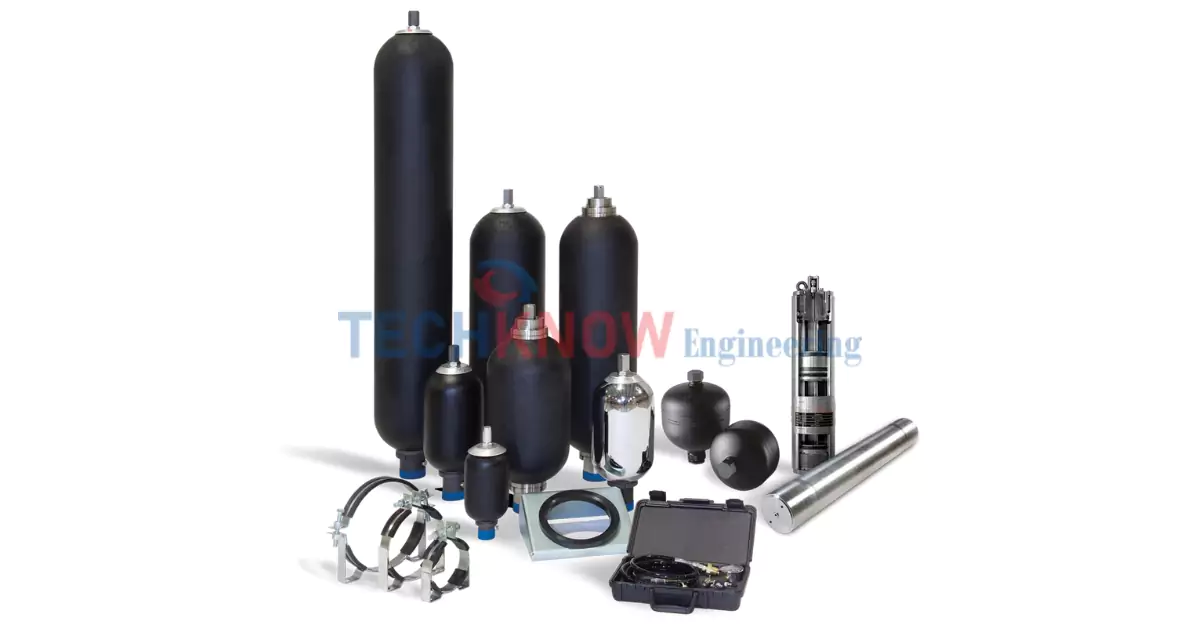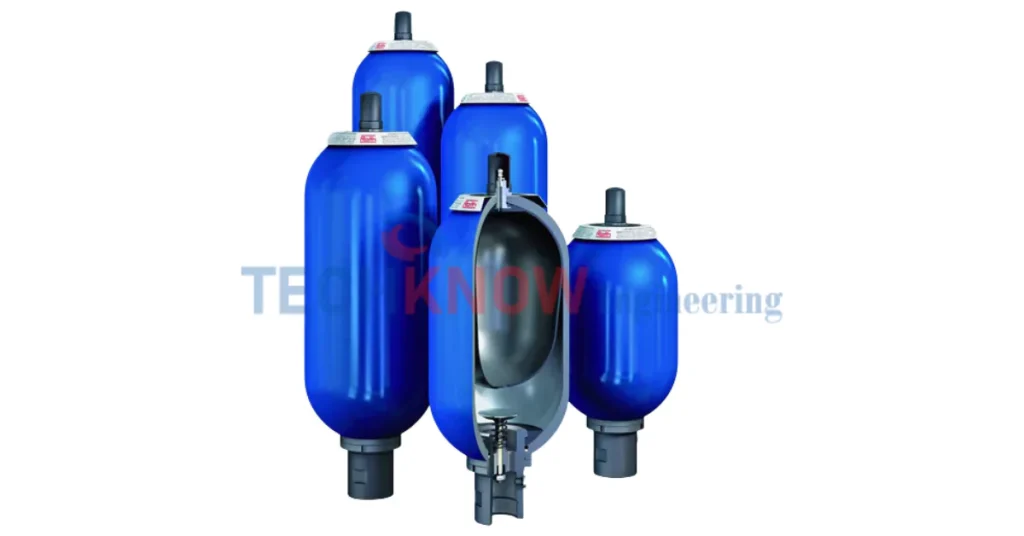What is a Hydraulic Accumulator? Types, Uses, and Trends
The hydraulic world is fueled by intricate systems that ensure efficiency, safety, and optimal performance. One essential component at the heart of this machinery is the hydraulic accumulator. Although often overlooked, accumulators play a pivotal role in a wide range of applications, from energy storage to emergency power backup systems.
Techknow Engineering Enterprise explore what hydraulic accumulators are, their types, common applications, and the exciting trends shaping their future. Whether you’re an engineer, mechanic, or fluid power professional, this comprehensive guide will equip you with the knowledge to better understand these vital components.
Introduction to Hydraulic Accumulators
Definition and Purpose
A hydraulic accumulator is a pressurized device used to store energy in a hydraulic system. It collects noncompressible hydraulic fluids under pressure and releases this stored energy when required, ensuring consistent operation. Hydraulic accumulators are essential for smoothing out pressure fluctuations, supplying additional fluid when needed, and improving the overall performance and longevity of hydraulic systems.
Think of an accumulator as a rechargeable battery for your hydraulic system. It stores energy in the form of pressurized fluid, ready to deliver it on demand in the form of heightened power or quick responses. This capability makes it indispensable for systems requiring precision, reliability, and efficiency.
Brief History and Evolution
The concept of the hydraulic accumulator dates back to the early industrial revolutions. With the rise of advanced manufacturing industries, the need to regulate fluid power more efficiently became apparent. Over time, advancements in material science and fluid dynamics have propelled the development of modern accumulators, shifting from heavy, rudimentary designs to lightweight and high-performing components like the HYDAC accumulator series.
Types of Hydraulic Accumulators
Different industries and applications require specialized types of hydraulic accumulators. Here are the three most common types:
Bladder accumulators consist of a flexible bladder inside a pressure vessel. Hydraulic fluid is stored on one side, while gas (usually nitrogen) fills the bladder. When pressure increases, the bladder compresses, storing energy.
Advantages:
-
- Fast and efficient response times
- Can handle high cyclic loads
Disadvantages:
-
- Bladders may deteriorate over time
- Limited gas volume compared to piston accumulators
Example Product: HYDAC’s hydraulic bladder accumulator is among the industry’s most renowned, delivering exceptional performance and reliability.
Similar to bladder accumulators, diaphragm accumulators use a flexible membrane (diaphragm) to separate the gas and fluid. They are compact and designed for systems with lower capacity requirements.
Advantages:
-
- Compact size
- Low maintenance
Disadvantages:
-
- Limited capacity
- Not suitable for extreme pressure ranges
3. Piston Accumulators
Piston accumulators use a piston to separate the gas and hydraulic fluid internally. These are particularly well-suited for high-pressure and high-volume applications.
Advantages:
-
- High capacity and pressure range
- Longer lifespan under demanding conditions
Disadvantages:
-
- Higher initial costs
- Requires more maintenance than bladder or diaphragm variants
Comparison Table
| Type | Advantages | Disadvantages |
|---|---|---|
| Bladder Accumulators | Quick response, high efficiency | Bladder wear over time |
| Diaphragm Accumulators | Compact design | Limited capacity |
| Piston Accumulators | Wide pressure range, durable | Higher costs, more maintenance |
Applications of Hydraulic Accumulators
Hydraulic accumulators are versatile and solve unique challenges across industries. Here are the most common uses:
1. Energy Storage
The primary function of a hydraulic accumulator is to store energy. During low-demand periods, the system stores hydraulic fluid under pressure. When the demand spikes, it releases the energy instantly, ensuring smooth operations.
- Example: Heavy machinery like cranes and excavators rely on accumulators to store energy for peak loads.
2. Pulsation Dampening
Accumulators absorb pressure fluctuations within hydraulic systems, minimizing vibrations and protecting components from wear and tear.
- Example: HYDAC accumulators prevent damages in hydraulic systems by smoothing pressure pulsations caused by pumps.
3. Emergency Power
Accumulators act as a backup power source in emergency scenarios by supplying hydraulic fluid when the main system fails.
- Example: Aircraft landing gears depend on gas accumulators to ensure emergency deployment.
4. Weight Compensation
Hydraulic accumulators balance loads or counteract weight in industrial processes.
- Example: Assembly lines and robotic arms use hydraulic accumulators for precise load management.
Future Trends in Hydraulic Accumulators
The landscape of hydraulic accumulators is continually evolving in response to industry needs, advancing technology, and environmental priorities. Here’s what’s trending:
Technological Advancements
Innovations like real-time monitoring systems and hydac accumulator charging kits are transforming how accumulators are managed. Advanced hydraulic system accumulators now come equipped with sensors to monitor pressure, temperature, and gas levels.
- Example Trend: Smart accumulators using IoT sensors for predictive maintenance.
Environmental Considerations
The focus on eco-friendly industrial practices is giving rise to accumulators made with sustainable materials. There’s also a push for designing systems that minimize energy wastage and maximize resource efficiency.
- Example Trend: The inclusion of low-impact hydraulic bladder accumulators compatible with biodegradable fluids.
Industry Outlook
With industries like renewable energy, automation, and aerospace rapidly expanding, the demand for high-pressure accumulators, hydac filters, and advanced accumulator accessories will only increase.
Projected Growth Areas:
-
- Hydac international’s cutting-edge accumulator systems
- Renewable energy storage solutions using smart accumulators
Take Your Knowledge Further
Hydraulic accumulators are more than just storage devices; they are essential components that power countless applications across industries. By understanding their types, uses, and emerging trends, professionals like you can unlock unprecedented efficiency and performance in your hydraulic systems.
Looking to upgrade your systems with the best in the market? At Techknow Engineering Enterprise, we provide premium HYDAC accumulators, gas accumulators, and other top brands like Parker and EPE Process. Our team also offers expert guidance and access to high-quality accumulator accessories, like the hydac accumulator charging kit.
Explore our range of hydraulic accumulators for sale or contact our team for tailored solutions.
Hydraulic Accumulator

Hydraulic accumulators are vital components in hydraulic systems, offering energy storage, shock absorption, and pressure maintenance. They improve system efficiency and reliability across industries like construction, manufacturing, and renewable energy. Stay ahead by understanding their benefits and innovative trends.
Product Brand: Techknow Engineering Enterprise
Product Currency: INR
Product In-Stock: InStock
5



